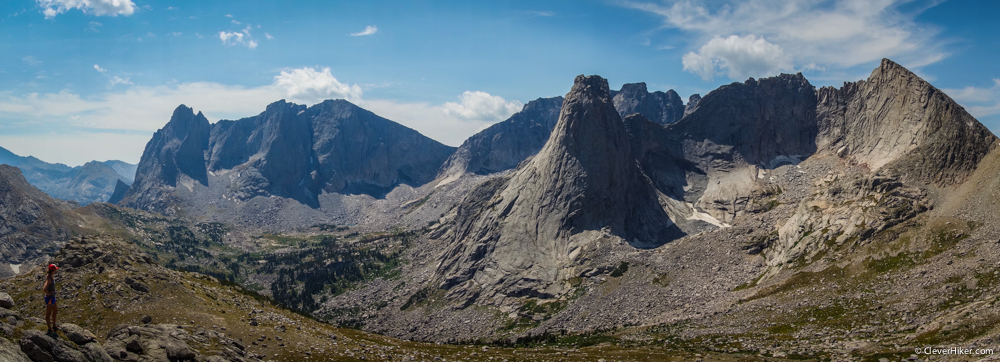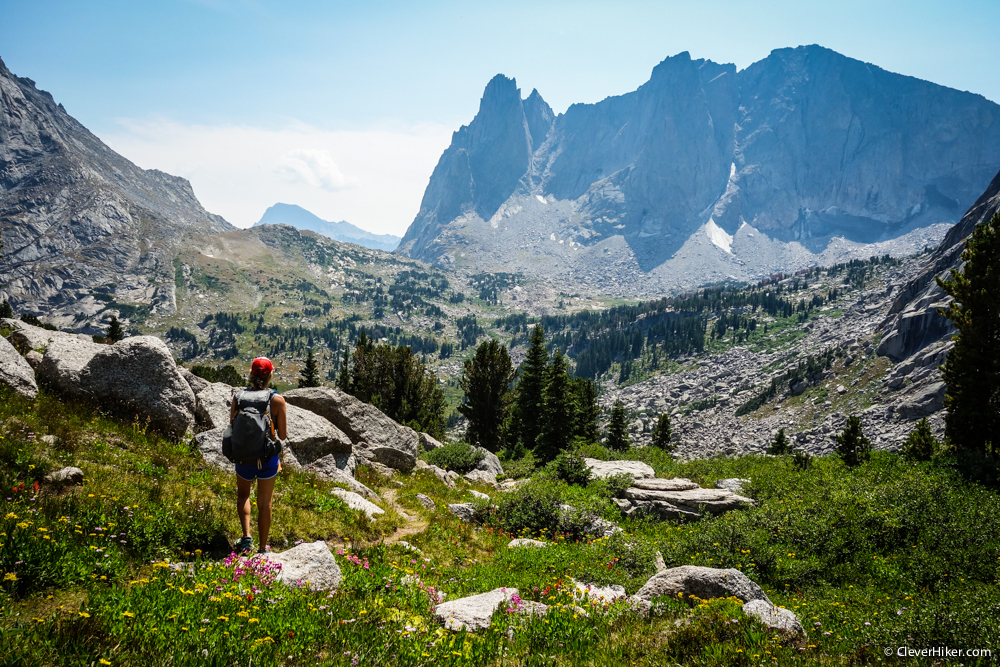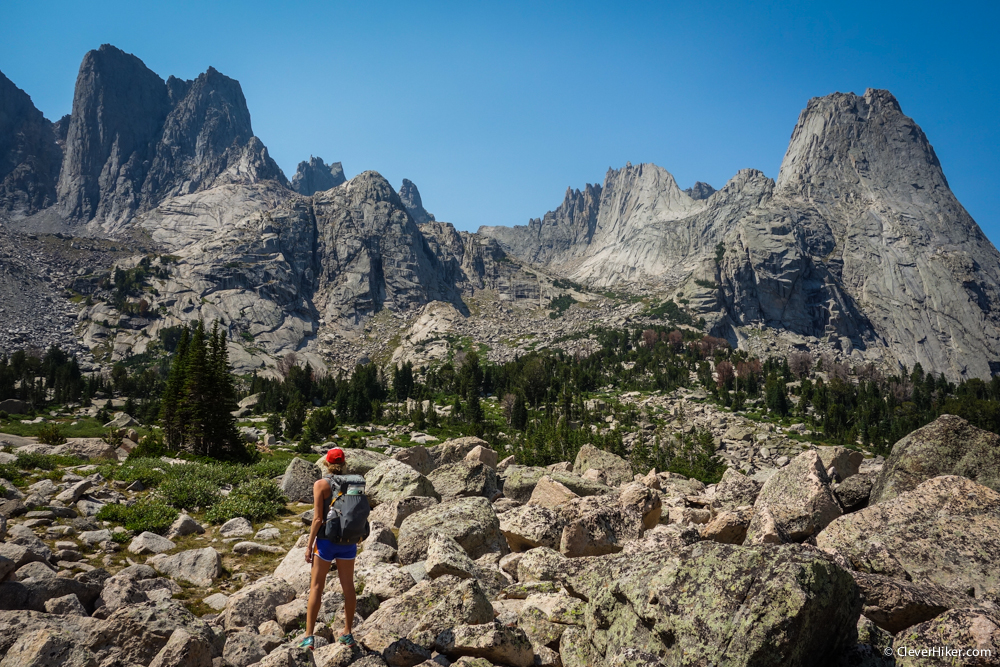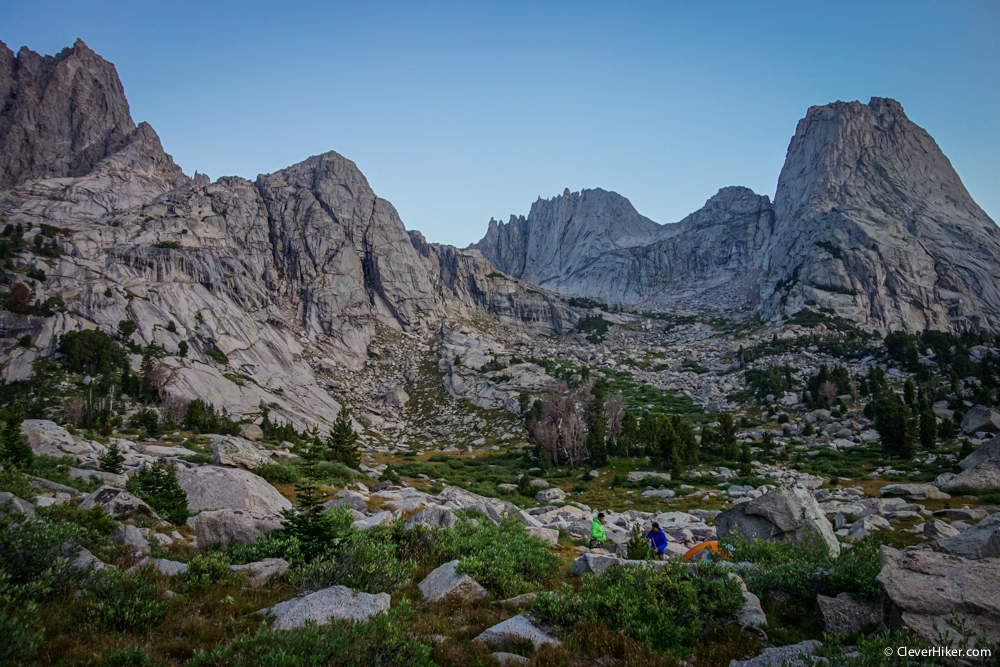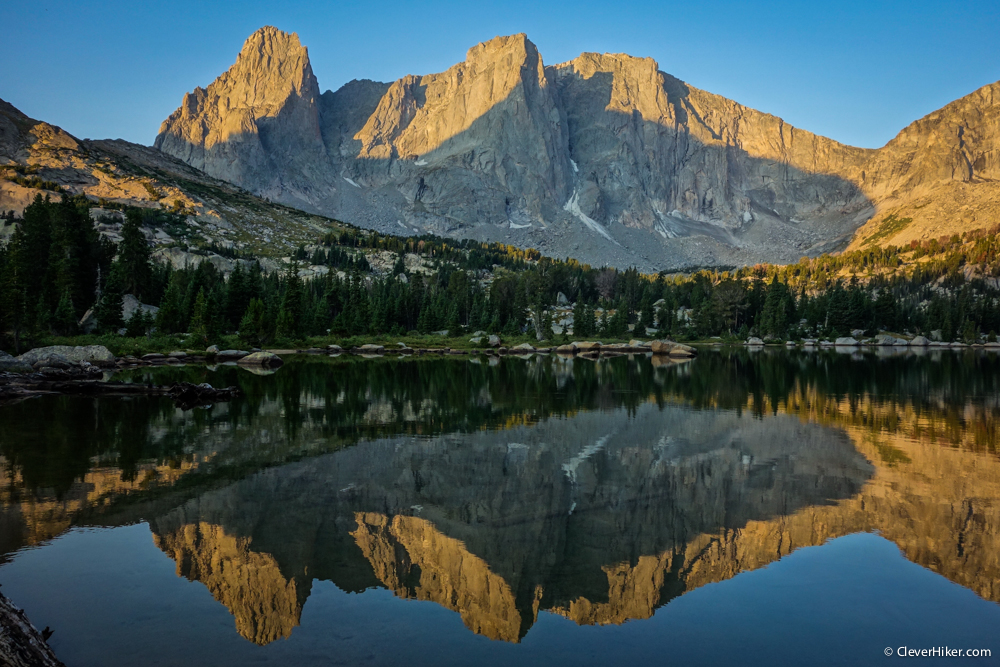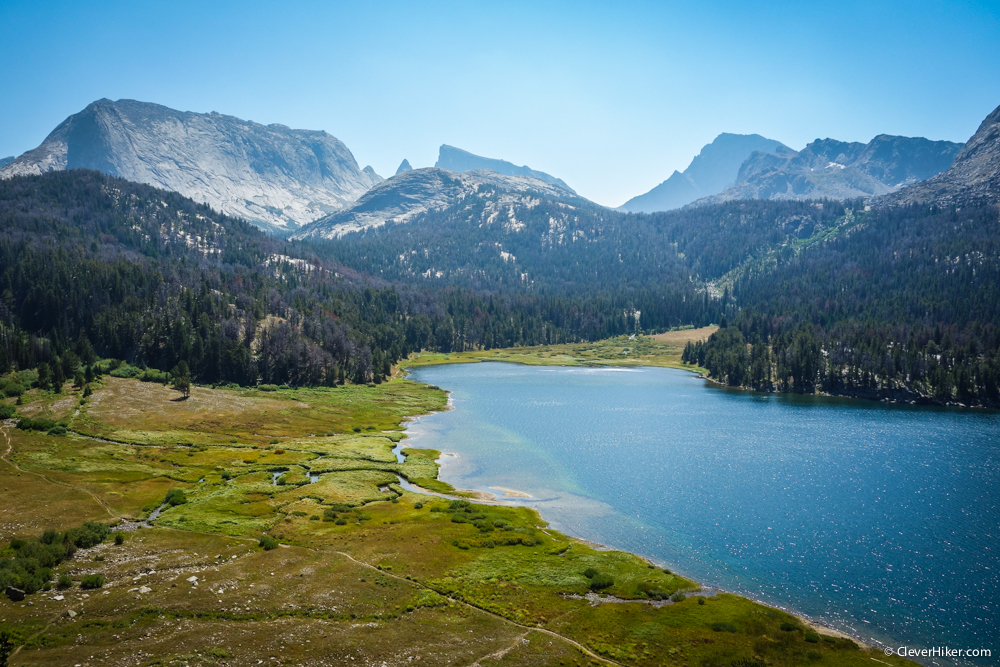
The Wind River Range in Wyoming is a place you truly have to see to believe. It’s an outdoor adventurer’s dream come true. Immense glacier-carved granite spires tower over crystal-clear lakes, rolling meadows, and fields blanketed by high-alpine wildflowers. It’s one of the most stunningly beautiful places we’ve ever seen. If you haven’t been to Wyoming’s Wind River Range, start planning a trip there now.
The Cirque of the Towers is one of the most iconic and easily accessible stretches of the Wind River Range and this 3-day itinerary is just barely enough to get a taste but fits well into an (extra) long weekend.

Pros
- Jaw-dropping Views
- Easily Accessible
- Seasonal Wildflowers
- Immense Glacial-Carved Granite
- Pristine Lakes & Rivers
- Excellent Backcountry Fishing
Cons
- Some Extremely Steep Climbs & Descents
- Some “Off-trail” Navigation
- No Campfires
- Seasonal Bugs & Snow
Permits
No permits are required to backpack, camp, or climb in this section of the Winds. If you had your sights set on a permit-based hike, like something in Yosemite, and it didn’t pan out, this is an exceptional alternative.

Route Summary
This loop starts and ends at the Big Sandy Trailhead. A very small portion of this loop requires backtracking, so you’re on new trail for the majority of your trip, which is ideal.
The total distance of the loop is about 24 miles, making it a great 2-4 day trip depending on your hiking style and fitness. Part of this loop (the section over Texas Pass) is technically “off trail,” so the exact distance of the loop is tough to pin down. The “off-trail” section is not marked on the map, but there is a trail and rock cairns to follow. The route along the off-trail section is not always as easy to follow as the official trail, but it is still well defined. That said, I’d definitely carry a good map and compass and know how to use them.
Big Sandy Trailhead (9,100 Ft) To Shadow Lake (10,300 Ft) – 10.9 Miles
Gradually gain 1,200ft of elevation through gentle and picturesque terrain. Pass by Mirror Lake, Dad’s Lake, and Marm’s Lake before making the turn-off to Shadow Lake. There are ample opportunities for camping and side trips along this less traveled side of the loop.
Shadow Lake (10,300 Ft) To Texas Pass (11,500 Ft) – About 2 Miles
After Shadow Lake the official trail ends and you’ll travel “off trail.” There is still a trail to follow, but keep your wits about you. Travel along the North side of Shadow Lake and make a short climb to a Billy’s Lake (unnamed on the map). Travel along the northwest side of this lake and continue up the valley. Continue your gradual climb to Barren Lake (also unnamed). Pass along the southern edge of this lake to find the fourth lake in this series, Texas Lake (unnamed as well). From Texas Lake (10,750 ft) you’ll have a short but steep climb south to the top of Texas Pass (11,500 ft).
Texas Pass (11,500 Ft) To Lonesome Lake (10,200 FT) – About 1 mile
From the top of Texas Pass you’ll get your first view of the Cirque of the Towers. Pingora Peak, a popular climb, is the large spire set in front of the Cirque. Descend along the loosely marked trail towards the western shore of Lonesome Lake. There is no camping allowed within ¼ mile of Lonesome Lake. The main camping area for the Cirque is located a short climb above Lonesome Lake to the southwest. There are lots of little loose unmarked trails throughout this picturesque area where campsites (and campers) are common. For a short sidetrip, head east along the official trail to Lizard Head Meadows (about 2 miles).
Lonesome Lake (10,200 FT) To Jackass Pass (10,750 Ft) – About 1 Mile
The official trail can be found to the east of Lonesome Lake and makes a moderate ascent to Jackass Pass. If you camp in the area above Lonesome Lake to the southwest, there is an alternate route that goes to a lower unmarked pass to the southwest of Jackass Pass. This is the most common route for those camping in the Cirque. After crossing the unmarked pass, the trail boulder hops along the west side of Arrowhead Lake (the official trail is on the east side) and meets up with the official trail south of Arrowhead Lake.
Jackass Pass (10,750 Ft) To Big Sandy Lake (9,700 Ft) – About 2.4 Miles
From Jackass Pass (or the lower unmarked pass to the southwest) the well-marked trail descends and eventually hits a series of switchbacks that lead down to Big Sandy Lake. Big Sandy is a picturesque and easily accessible lake, making it a popular choice for camping. It is a good spot for setting up a basecamp for day trips in the surrounding area, but it is far from secluded.
Big Sandy Lake (9,700 Ft) To Big Sandy Trailhead (9,100 Ft) – 5.6 Miles
The walk from Big Sandy Lake is well-traveled and gentle. For a less traveled and more picturesque route, take the trail that goes to Diamond Lake and V Lake. This route will add .4 miles and no elevation gain to your trek. There are a couple of decent camping opportunities along this route as well.
Best Time To Travel
In general July-September is the best time to travel to this area. Snowpack is a key factor for trip planning in the Winds. Some years a heavy winter snowpack and early season storms will keep trails covered in snow well into July. In warmer years with lighter snowpack, June backcountry trips are possible. The same is true for autumn hiking – some years early snowstorms make this area inaccessible and other years it’s passable (but perhaps cold) into October.
July and August are usually great for wildflowers. That’s also the time when mosquitoes and biting flies will be the worst though. So use a combination of permethrin on your clothing and a small amount of 30% DEET on exposed areas for full protection. Mid-August to mid-September is generally a great window for this area as well because crowds will be minimal and bugs will be gone.
Afternoon showers are common during the summer months in the Winds and thunder and hailstorms are also not out of the ordinary. There is a year-round possibility of snow here, so pay close attention to the weather and be prepared for any change in conditions.
Difficulty
Difficulty depends on your experience, physical fitness, pack weight, & weather conditions. This is not a technically demanding hike, but there are a few good climbs and some basic off-trail navigation along the way. For most people, this loop is moderately difficult. Some sections are quite easy, and some sections are a little tricky and physically demanding.
As always, the heavier your backpack is, the harder your hike will be. So do yourself a favor and pack light. For lightweight hiking tips and gear recommendations, check out our Lightweight Basics Video Series and Gear Guides.

Solitude
The Cirque of the Towers is one of the most popular destinations in the Wind River Range, so you won’t be alone along this route. It is a popular climbing area. Lots of climbers set up base camps in the Cirque and climb during the day.
While the traffic in the Cirque can be heavy at times (summer weekends in particular) the terrain is good for tucking away a tent in a hidden camp spot, so you won’t feel like you’re camping on top of other hikers. In addition, the first section of this loop (Big Sandy to Shadow Lake) sees a lot less traffic. In addition, we didn’t find the traffic along the trail to be overwhelming and the scenery is well worth it. If you’re looking for complete solitude, there are less popular trails out there, but on the whole, there are many, many moments of quiet to be found.
Elevation
The Wind River Range runs along the Continental Divide and boasts some high elevations. The highest point on this loop is Texas Pass at 11,500 feet above sea level. Even the low point along this trip (Big Sandy Trailhead) is at 9,100 feet, so you’ll be at high elevation for the duration of the trip.
Know the symptoms of altitude sickness and know what to do if you encounter it. It’s never a good idea to travel from a low elevation to a high elevation like this without a few days to acclimate. Check out our high elevation hiking and lightning storms guide for more info.

Regulations
- Groups of 15 or less
- No camping within ¼ mile of Lonesome Lake
- No camping within 200ft of lakes and trails
- No campfires
- No biking
- No motor vehicles or motor tools
- No damaging live vegetation
- LNT – If you pack it in, pack it out
Maps & Guidebooks
- Hiking Wyoming’s Wind River Range – This is an excellent book with pictures, highlights, and detailed descriptions of hiking trails throughout the Winds. It’s not specifically designed for backpacking trips, but it does reference good multi-day trips and tells you how to string together hiking trails for longer trips. This is a very useful book that I highly recommend for this trip and others.
- Wind River South Range Map – We chose this map over the Southern Wind River Range Hiking Map because it was made more recently, is more durable, has shaded topo relief, and is easier to read. It’s an excellent map that I highly recommend.
- FarOut App – Continental Divide Trail Wyoming – Cirque of the Towers is a recognized alternate route along the Continental Divide Trail so it appears in the FarOut CDT guide. Though the entire Wyoming section of this app covers far more than you need for this particular trip, you benefit from all of the waypoints and comments left by CDT thru-hikers from earlier in the season.

Water
Water is plentiful along this trail and is easily accessible from lakes and streams. Carry enough water to get from one source to the next as well as a lightweight water purifier.
Bear Spray & Food Storage
There are bears in the Wind River Range – both grizzly bears and black bears. So protection and food storage are critical. Other people can be a blessing and a curse. On the one hand, the voices and sounds of passing backpackers may keep bears away from the immediate trail corridor. However, more people equals more food and increases the likelihood that someone near you will be storing it improperly. It’s better to take the correct precautions just in case.
We carried bear spray when hiking in the Winds because there are grizzly bears in the area. We knew it was highly unlikely that we would see any, but if we did, we wanted to be prepared to protect ourselves. Bear spray is an essential item when hiking in grizzly country. The chances of a negative encounter are rare, but it can save your life if you have it and know how to use it.
Food storage is another important consideration. Make sure you know how to hang a bear bag properly or carry a food storage container. Bear canisters and Ursacks are the most effective storage methods and the easiest to use. There are no food storage requirements for this area, but you should always store your food properly. That will protect against bears and keep small critters from chewing through your spendy backpacking gear.
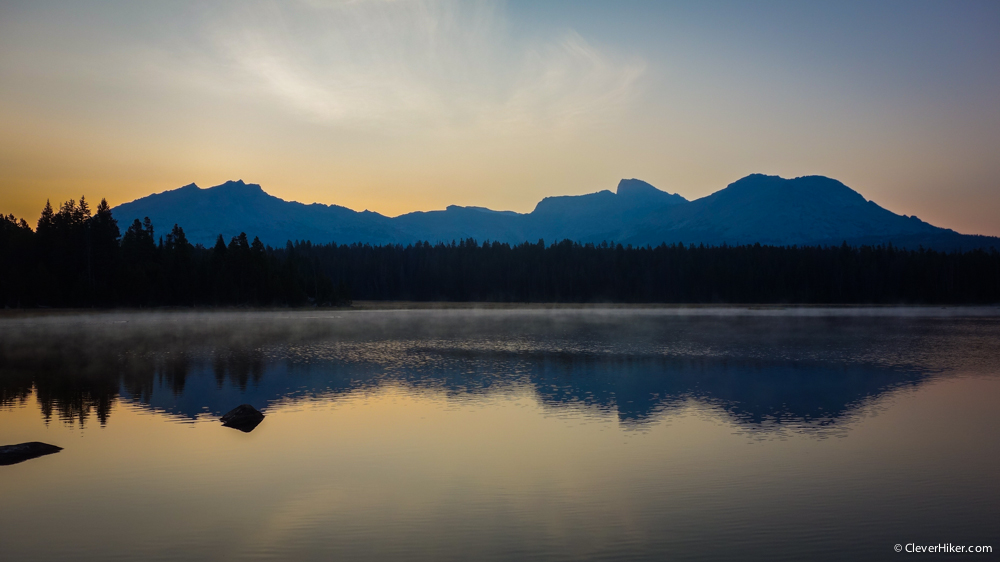
Getting There
The Big Sandy Trailhead is where this loop hike starts and ends. This is a popular trailhead because it’s the best access point for the Cirque of the Towers and Pyramid Lake. Getting to this trailhead will require 27 miles of dirt road driving. The last 10 miles are pretty rough with lots of potholes. We were able to get to this trailhead in a sedan, but it was slow going.
Be sure to have maps downloaded on your phone to use in airplane mode or take screenshots and write down the directions to the Big Sandy Trailhead. There are signs to the trailhead/campsite, but it can still be confusing and you won’t have any phone signal once you get out there.
What To Pack
We prefer lightweight backpacking because it’s more comfortable and it allows us to cover more ground with less effort. For recommendations on our favorite lightweight backpacking equipment, check out our comprehensive Gear Guides and Top Picks pages.
Tent
We used the Zpacks Duplex tent on this trip. We love its combination of incredibly low weight and livability and that’s why it’s one of our top picks on our best lightweight backpacking tents list.
Backpack
We used Gossamer Gear Gorilla on this trek. It’s lightweight, convenient, comfortable. Check out our list of the best lightweight backpacking packs for other options.
Sleeping Bag
We used the Western Mountaineering UltraLite. It is lightweight and incredibly warm. We have a complete list of picks in our guide to the best backpacking sleeping bags.
Sleeping Pad
We both used the Therm-a-Rest NeoAir XLite sleeping pad on this trip. It’s light, comfortable, warm, and make our list of the best backpacking sleeping pads.
Cooking System
We used the BRS Stove and Snow Peak Mini Solo Cookset. Take a look at our best lightweight stoves and cookware lists.
Water Purifier
We used the SteriPEN Ultra as our main purification method on this trip. It’s lightweight, works fast, and doesn’t require any pumping/squeezing or chemicals. Check out our best water purifiers list for our other top recommendations.
Shoes Or Boots
We wore Saucony Peregrine trail runners (men’s and women’s) on this trail and they were excellent. We like trail runners, but if you prefer boots, make sure they’re lightweight and break them in really well before your trip.
Headlamp
A small headlamp like the Petzl Actik Core is an affordable, bright, and lightweight option.
Food
When backpacking in the Wind River Range you’ll have to carry all your food. For some suggestions on how to do backpacking food well, check out our favorite freeze-dried meals and recipes.
Food Storage
For this trip, we brought an Ursack for food storage. Make sure you know how to hang a bear bag properly or carry a food storage container. Bear canisters and Ursacks are the most effective storage methods and the easiest to use.
Bear Spray
The Wind River Range is home to a healthy grizzly and black bear population. You should always hike with bear spray and know how to use it properly.
Clothing
Take a look at our favorite hiking/backpacking clothing items from our Top Gear list.
Map and compass
We hiked with the Wind River South Range Map. In addition, we always hike with a compass.
First aid kit
Always bring a small personalized first aid kit. We used the .7 Ultralight Kit and added extras, like painkillers and personal medications.
Sun protection
Sunglasses (polarized recommended), sunscreen, and SPF lip balm are an absolute must.
Pocket knife
We brought along a small Swiss Army Knife, which comes in handy here and there.
Other items
- Small towel: the Personal PackTowl is great.
- Cash and ID
- Permits
- Personal toiletries
- Hand sanitizer
- Wet wipes
- Insect repellant
- Camera – Sony RX100
Additional Resources
















